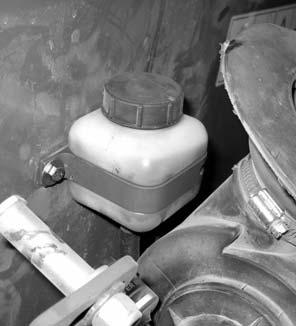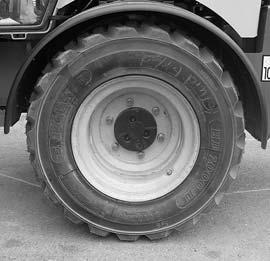
1 minute read
Brake Fluid Reservoir
Checking Brake Fluid Reservoir Level
1.Perform the “Mandatory Safety Shutdown Procedure” on page8.
2.Open the engine hood.
3.The brake fluid reservoir (1, Figure 95) is located against the operator platform at the front of the engine compartment.

4.Carefully remove the brake fluid reservoir fill cap (2, Figure 95). Be careful not to allow dirt to fall into the reservoir.
5.The brake fluid reservoir fluid level should not fall below 1/2 full. Add automatic transmission fluid as required.
Wheels and Tires

Wheel Fasteners
Wheel fastener torque must be checked before initial operation and every day thereafter until the wheel mounting hardware torque stabilizes. Torque the wheel fasteners in the order shown (Figure 96). When tires are removed and replaced, this procedure must be repeated. See “Wheels” on page31 for wheel fastener torque specifications, wheel rim dimensions and wheel offset measurements.
Inflating or servicing tires can be dangerous. When possible, trained personnel should service and mount tires. To avoid possible death or serious injury, follow the safety precautions below.
To keep tire wear even, rotate the tires from front to rear and rear to front.
Important: Keep the same size tire on each side of the loader to prevent excessive wear on tires. The tread bar of all tires should face the same direction.
•Be sure the rim is clean and free of rust. Lubricate the tire beads and rim flanges with a soap solution. Do NOT use oil or grease.
•Use a clip-on tire chuck with remote hose and gauge, allowing you to stand clear while inflating the tire.
•Never inflate beyond 35 psi (2.4 bar) to seat the beads. If the beads have not seated by the time the pressure reaches 35 psi (2.4 bar), deflate the assembly, lubricate the tire and the rim where they contact each other, reposition the tire on the rim and re-inflate. Inflation pressure beyond 35 psi (2.4 bar) with unseated beads may break the bead or rim with explosive force sufficient to cause death or serious injury.
•After seating the beads, adjust the inflation pressure to the recommended operating pressure.
•Do not weld, braze or otherwise attempt to repair and use a damaged rim.
Checking Tire Pressure
Correct tire pressure should be maintained for all tires to enhance operating stability and extend tire life.
Note: See tire sidewall for inflation pressures.







